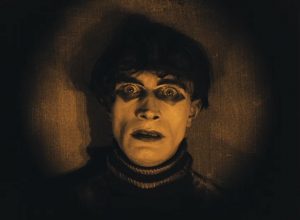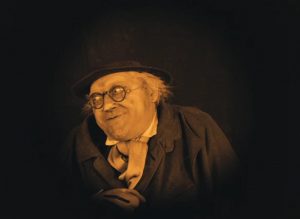
The Miami Jewish Film Festival celebrated the centennial anniversary of The Cabinet of Dr. Caligari last Saturday at the Coral Gables Art Cinema as part of their After Hours program. Restored in 4K, this German expressionist film was shown with a newly commissioned live score by sound artist Richard Vergez. Prior to the screening, the night’s program featured international shorts in competition at the festival. The combination of old and new, silent and sound, was an immersive experience that left ears ringing in its wake.
According to Roger Ebert, The Cabinet of Dr. Caligari is “the first true horror film,” so it’s no surprise it had an impact on American cinema. The film creates a nightmare realm, painting a picture of abstract light and shadow. Although it’s obvious to a modern audience that this twisted world is all sets and backgrounds, remove the apparent fake nature and primitive special effects, and the film is still effective in conveying a dark, twisted world overcome by delusion. Organized as a frame story – a literary technique where there’s a story within a story, and the prologue and epilogue establish the main narrative – we travel from the present to past, and back again revealing everything to be a madman’s hallucination. Visual style and narrative form stand at the forefront and can be clearly seen to have influenced the later genre of film noir.
Richard Vergez’s sonically disturbing score began with a constant rumbling piano that slowly built across Act 1 bringing the viewer to the edge of their seat. Unnerving to the core, the tension increased as the mystery continued, creating a constant ear twitch. Vergez accompanied every murder with a pulsing motif, eventually allowing the audience to recognize a murder had occurred without the need to see it. Similar to what occurred in the original King Kong, take away the score, and what was meant to be scary is now comically unimpressive.

To the modern viewer, this silent horror film is so slow following along becomes a chore. Yet, the contemporary score expresses a stimulating century-old narrative shaking you from the inside out. The engrossing experience of The Cabinet of Dr. Caligari and sound artist Richard Vergez restored the value of this classic film for a 21st century audience. The film marks my first and most likely last horror film of the year. But the impact it has left will never be forgotten. I clearly felt it when the music stopped, the lights came on, and the pain in my temple settled. Given the chance to go back, I’d tell the coordinators of the event to warn any audience members who suffer from migraines.
 Julia Burgos is still sleep deprived in her last semester, thanks to the anxiety of graduation and her array of streaming subscriptions.
Julia Burgos is still sleep deprived in her last semester, thanks to the anxiety of graduation and her array of streaming subscriptions.
